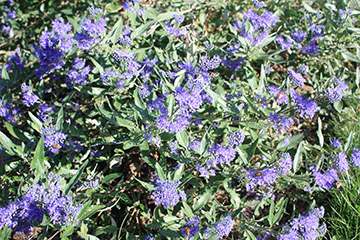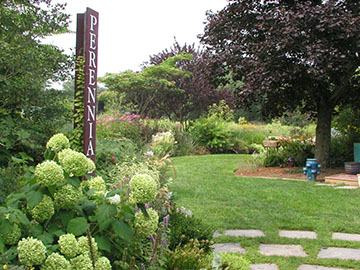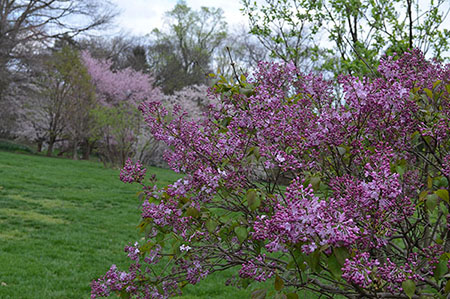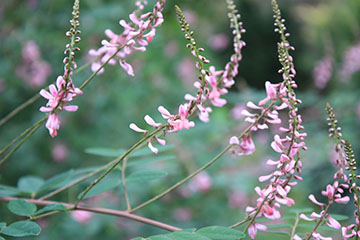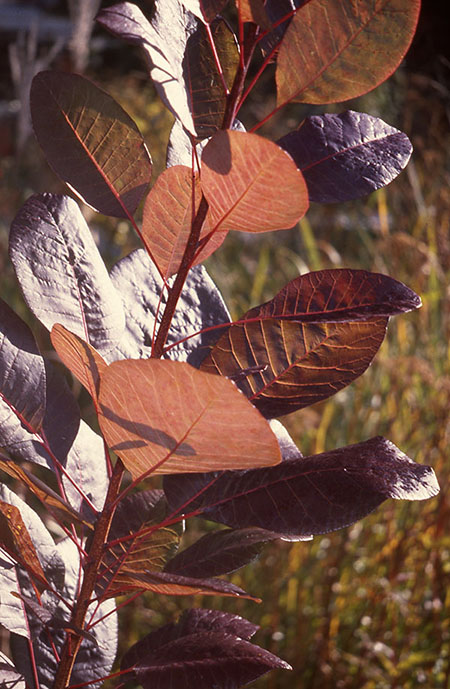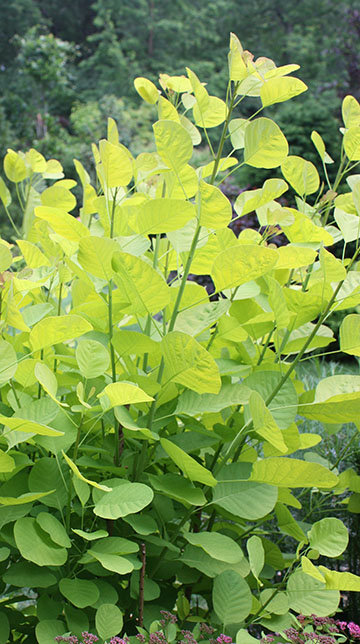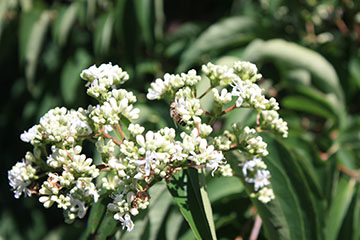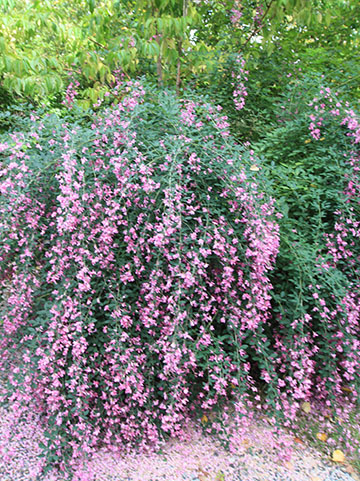Spring 2019 Newsletter
| Foliage Color, Texture and Form | Mastering the Mixed Border | Introduction to Herbal Remedies |
| Entry Garden Etiquette | Fragrant Gardens | Spring Pruning |
Foliage Color, Texture and Form
The spring garden season is distinguished by a momentous release of energy, that of bursting buds and emerging shoots that transform into unfurled leaves and colorful flowers. It is all very dynamic and dazzling, perhaps even a bit chaotic. This color celebration paints a surreal landscape composed of pink trees; lavender, red and yellow shrubs; and a ground plane tinted blue with bulbs. Thank goodness it’s ephemeral! After all that is the nature of flowers.
It is the leaves that offer a myriad of shapes, sizes and colors that sustain the garden through the season. Their foliage form and color is where I start when designing a garden, with subliminal images of brilliant, fragrant and seasonal flowers always close, in my mind’s eye. Colorful foliage can offer either an echo or a contrast to flowers and intensify the design effect. For example, the chartreuse leaves of Spiraea thunbergii ‘Ogon’ offer a delicate foreground to the golden bells of Forsythia. The fine textured form of Spiraea ‘Ogon’ emerges with a cloud of white flowers soon after the Forsythia blooms pass. It then holds its pale spring-fresh colored leaves throughout the summer. Chartreuse is the definitive and refreshing color of spring.
Spiraea thunbergii ‘Ogon’ is a favorite and very versatile performer. This fine textured, five-foot shrub is at home in full sun or partial shade, and is an unparalleled foil through the season for colorful flowers. It sets off red-hot daylilies, such as Hemerocallis ‘Chicago Apache’ or the cool-blue of Siberian Iris ‘Sally Kerlin’ and the violet blooms of Saliva nemorosa ‘Caradonna’ and even the blue leaves of Hosta ‘Halcyon’.
The characteristics of leaf texture and shape has significant design impact for pleasingly pairing plants. The variations of simple, lobed or pinnately compound leaf form as well as fine or coarse texture, and its relationship to planting design is a principle lesson to grasp. Color design is not exclusive of form. The same chartreuse-colored leaves, whether lobed, like ninebark (Physocarpus opulifolius ‘Nugget’), or simple, as in the leaf of Spiraea, or the pinnately compound leaf of Sorbaria sorbifolia ‘Sem’ are not at all interchangeable in designing pleasing plant combinations. The powerful pairing of the red flowered Hemerocallis ‘Chicago Apache’ and Spiraea ‘Ogon’ is diminished by the coarser texture of ninebark and would look messy with the Sorbaria. However, the finer textured flowers of Crocosmia ‘Lucifer’ works well with ninebark and the coarser compound leaves and yellow flowers of Mahonia bealei sing in harmony with Sorbaria ‘Sem’. This is the law of dynamic contrasts.
Sorbaria sorbifolia (Ural False Spiraea) is one of the first shrubs to leaf out, emerging in March! It is very cold hardy to Zone 2. The cultivar ‘Sem’ is a new form sporting chartreuse, pinnately compound leaves and red midribs on first flush. Sorbaria ‘Sem’ is a spreading shrub that reaches six feet in height and sports foamy white flowers in July. The linear, blue leaves of switch grass (Panicum virgatum ‘Dallas Blues’) is a pleasing contrast to Sem’s feathery foliage. Add Russian sage (Perovskia atriplicifolia), Yucca filamentosa ‘Bright Edge’, Coreopsis x ‘Full Moon’, Spiraea japonica ‘Gold Dwarf’ and Lady’s Mantle (Alchemilla mollis) for the beginnings of a sensational garden. Repeat the chartreuse colored leaves with Cotinus coggygria ‘Golden Spirit’ echoed by the pale-yellow flowers of Coreopsis x ‘Full Moon.
The color red is heavy, regardless of leaf size, and advances towards you in space. In counterpoint the color blue recedes. The maroon-leaved smoke bush (Cotinus coggygria ‘Royal Purple’) adapts to severe pruning. It can be coppiced to the ground, which controls its size to four-to-five feet. The rounded leaves pair up beautifully with the pinnately compound foliage of the red-leaf rose (Rosa glauca). Add more maroon foliage with Eupatorium rugosum ‘Chocolate’. Shift the color spectrum from blue-red foliage to orange-red flowers such as Hemerocallis ‘August Flame’. The violet flowers of Russian sage add heat to this fiery combination..
Many herbaceous perennials have form and foliage that is as tough as any woody tree or shrub. Bluestar species, such as Arkansas bluestar (Amsonia hubrichtii) and willowleaf bluestar (Amsonia tabernaemontana var. salicifolia), top my list. Amsonia blooms with blue flowers in May, but the real show is the fine textured, quill-like green leaves arranged around two-to-three foot stems. It is indestructible, standing up to heat and drought in full sun and remaining unblemished. Late September brings on a spectacular color change to butter yellow. Plant Amsonia as a hedge that never needs trimming, or in combination with daylilies and daffodils to obscure less than perfect foliage.
Bigroot geranium (Geranium macrorrhizum) is also high on my list of tough and beautiful perennials for foliage. It too is drought tolerant and thrives in partial shade to sun. The round, pleated leaves turn reddish in the winter and remain semi-evergreen. Geranium macrorrhizum and its cultivars make excellent low-maintenance groundcovers, a foliar skirt under Sorbaria sorbifolia ‘Sem’.
The fern family certainly provides a depth of leaf diversity. Their intricate furled fronds are memorialized in classic architectural details. Lush and luxuriant, ferns are also rugged garden plants. The evergreen Christmas fern’s (Polystichum acrostichoides) dark green leathery fronds make a great combination with the bold bronze leaves of Bergenia. Maidenhair fern’s (Adiantum pedatum) delicate filigree shows off next to large bold leaves of Hosta or Ligularia dentata ‘Desdemona’. Maidenhair ferns and moss makes a magic carpet under Japanese Maples. The family of lady ferns (Athyrium) offers a diversity of colored and patterned pinnae, a Victorian favorite. Silver and pink pigments many selections of Japanese painted fern (Athyrium niponicum ‘Pictum’). The statuesque Royal Fern’s (Osmunda regalis) pinnately compound, locust-like leaves stand three-to-four foot tall and are as handsome as any woody rival.
Embrace the different seasons in your garden, with the cycles of showy flowers and fruits. Design to sustain the vigor of spring, by planting a framework of fine and colorful foliage.
Warren Leach
Mastering the Mixed Border
Tranquil Lake Nursery has matured over the past twenty years, since I purchased the daylily and iris catalog business. The site has transformed from simple fields of daylilies and iris surrounding a house and random plantings of shrubs, to a complex of garden spaces with ten acres of colorful outlying production fields.
Tranquil Lake Nursery has matured over the past twenty years, since I purchased the daylily and iris catalog business. The site has transformed from simple fields of daylilies and iris surrounding a house and random plantings of shrubs, to a complex of garden spaces with ten acres of colorful outlying production fields.
The gardens express our passionate love of plants mixed with horticultural expertise and artful design. They also offer a long-season of interest to complement the daylily and iris fields and nursery container sales areas. Our philosophy is to grow the perennials, grasses, shrubs and trees in our own gardens to show off their ornamental characteristics and test their mettle through the many seasons.
Over the years we have written about plants that are drought tolerant, offer winter interest, produce colorful foliage and offer many other outstanding attributes. We have also provided design tips for use in the garden. These recommendations and observations have been based on the twenty years of practical experience from making our own gardens as well as the gardens we have designed for customers.
The many gardens at Tranquil Lake Nursery can be defined as mixed borders. A mixed border is a gardens that combines woody trees and shrubs with herbaceous perennials, bulbs, annuals and even tender perennials. The principles of the mixed border can be adapted to any garden space from the entry garden to the back yard. They are also useful on any scale from tiny city lot to country estate.
Mixed borders provide interest in every season, utilizing all of the characteristics of plants from evergreen foliage to fall color, fruits, seed pods and blossoms. While every mixed border should be planned specifically to your site and conditions, the following tips are useful.
-
-
1. Designing gardens is laying out architectural space and then some! The three dimensions of space must harmonize with a fourth, the rhythm of time.
-
A good garden plan celebrates the changing seasons and accounts for the future growth of the plants.
-
2. Plan the mixed border to integrate shrubs and trees to provide both structure and multiple season interest.
-
3. Use colorful foliage to complement flowers and extend the seasonal span of color.
-
4. Space is defined by shape, texture and color of plants as well as the configuration of the bed line.
-
5. Create focal points that stop the eye and hold your gaze and also add to the sequence of the garden design.
-
Warren Leach
Introduction to Herbal Remedies
Peppermint, Lavender and Lemon Balm |
||
 |
 |
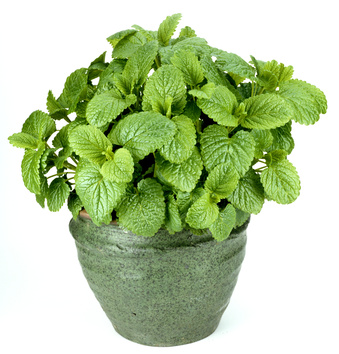 |
According to James A. Duke for Purdue University, “25% of modern prescription drugs contain at least one compound now or once derived or patterned after compounds derived from higher plants.” Before prescription drugs existed, people relied on plants as their medicine. Every culture has a long history of plant remedies passed down through the generations. Herbal folklore was the beginning of scientific research into pharmaceuticals. People would test, observe, and document the outcome of their experiences with different plants. Luckily, we have advanced light years - thanks to those who explored their surroundings and those who put their surroundings under a microscope - but that doesn’t mean our bodies wouldn’t benefit from utilizing herbs. While pharmaceuticals can treat illness, plant medicine can be incorporated into a balanced lifestyle keep us at our best.
There is something incredibly satisfying about growing your own ingredients for herbal remedies. When it comes to using plants to support our health, I believe in keeping it simple. The herbs we know and love are tried and true, and they have a lot to teach us. Whenever anyone asks me where to start their herbalism journey, I always recommend growing something. The experience of growing a plant can provide you with priceless insight that a book cannot. Assess your space - anyone can have an herb garden if they have sunlight and room for a pot. Depending on your space, try starting with 3-5 varieties of herbs. This will allow you to spend time getting to know each plant intimately: from how much sun they need, to soil and water preference, and bugs or diseases they are vulnerable to. Use a three-ring binder to make your own materia medica; keep any information you acquire on each plant you grow and journal your experiences with growing them. Include pictures - or if you’re artistically inclined, draw a sketch - of the plant in different stages of growth. Be sure to document recipes you try with measurements and the outcome. I often keep handouts I accumulate and copies of pages from my favorite books in sheet protectors to use as a quick reference. You can add dividers with labels to keep everything organized and even make a Table of Contents.
A few of my favorite low-maintenance herbs are lemon balm, peppermint, and lavender. These herbs are all members of the family Lamiaceae (aka Labiatae) - the Mint family. They are known for their strong aroma and square stems. Peppermint is a power-packed plant, containing volatile oils, flavonoids, tannins, as well as essential vitamins and minerals like magnesium, phosphorus, calcium, iron, and potassium. Peppermint is water-soluble, which means it is best taken with water. Not a bad thing - peppermint tea is delicious! In fact, peppermint is often added to herbal teas to balance more bitter herbs. Historically, peppermint was believed to ease indigestion, soothe muscle spasms, and relieve gas. This plant is often used during cold and flu season, and for good reason, as it is believed to be antimicrobial and effective against a range of bacterial, viral, and fungal infections. Peppermint has long been used for aches and pains, headaches, and to relieve nasal and sinus congestion. The refreshing scent is stimulating and may help to improve concentration and clear brain fog. Mint is easy to grow, so much so it is known to spread profusely in gardens, but can be controlled in containers. It likes rich soil, full sun, and moisture. It is difficult to grow from seed but can be propagated and divided from an established plant with ease. Peppermint is thought to be a pest deterrent - try keeping some containers on your patio or outdoor space where you lounge, or even in a sunny window inside. Though best harvested before it goes to flower (on a sunny morning after the dew dries), I always let some of the plant go to blossom for pollinators.
Lavender is a perennial shrub that is attractive to pollinators - watching hummingbirds dip their bills into the cup-like blooms is very entertaining. Lavender contains volatile oils, flavonoids, tannins, and more! The name came from the Latin word “lavare” which means “to wash” and was given to the plant by the Romans who added it to baths. Lavender is most commonly used for its pleasant smell, as well as its cleansing abilities. Historically, lavender was believed to be antibacterial and antiseptic, so it was used for disinfecting minor cuts and wounds, as well as easing pain and supporting the body's natural healing process. Lavender is a great plant to keep on hand for bugs, as it is thought to repel flies, mosquitoes, and moths, and may help ease the itch and pain of insect bites. Lavender soothes minor burns and may reduce scarring. As a nervine, it is used to aid the treatment of nervous system conditions like anxiety, depression, insomnia, and migraines. Lavender relaxes tension while also being uplifting. Lemon balm also contains volatile oils, flavonoids, tannins, and more. Its energy is cooling and it has a strong lemon smell with mild lemon flavor.
Lemon balm got its name from the Greek word for bee and is especially attractive to the pollinators. Rubbing lemon balm on empty hives may encourage bees to move in, and it is said that medieval beekeepers partook in this practice. Lemon balm takes some time to establish, but after the first year it will begin to spread. It is low maintenance, tolerates both sun and shade, and likes good drainage. Lemon balm can be grown from seed and also propagated from the plant itself. Historically, lemon balm is believed to soothe anxiety, nervousness, tension, and depression. Its uses are similar to its family member, peppermint; it is said to aid with digestion and concentration, deter pests, and ease nausea. The fresh leaves make an excellent hot tea or a cold infusion in the summertime. Harvest before the plant goes to flower in the late morning once the dew has dried but don't forget to let some of the plant go to flower for pollinators! They will appreciate it.
[Sources: The New American Herbal by Stephen Orr, Eyewitness Handbooks: Herbs by Lesley Bremness, Rodale’s Illustrated Encyclopedia of Herbs, The New Age Herbalist by Richard Mabey, Herbarium.theherbalacademy.com]
Article by Casey Downs, Long-Time, Tranquil Lake Nursery Employee and Proprietor of an on-line herb business: www.rosies-apothecary.com
Entry Garden Etiquette
The garden space between the street, driveway, walkway and your house offers a formidable first impression to someone arriving to your door. Thomas Church, landscape designer and author of Gardens are for People, wrote this about the importance of a well mannered entry garden:
"The psychology of arrival is more important than one thinks. If it is not obvious where to park, if there is no room to park when you get there, or the entrance is badly lighted, your guests have been subjected to a series of annoyances which will linger long in their subconscious. No matter how warm your hearth or how beautiful your view, the overall effect will be dimmed by these first irritations. Nothing justifies making an obstacle course out of the trip from the car to the front door.
It will require the finest food and the most comfortable chair to make up for being obliged to walk through mud, or having your hat knocked off by overhanging trees and your stockings ripped on the pyracantha."
Cultivate your entry garden to be a pleasurable experience and not inflict long lasting psychic sorrow. Select a planting palette that offers year-round beauty. Include evergreen trees and shrubs, sculptural branches, colorful twigs, fruits and foliage.
Japanese maples (Acer palmatum) offer a variety of textured and colored foliage as well as sculptural silhouettes in the winter. Under plant with the evergreen foliage of lenten rose (Helleborus) offering early spring blooms.
Witchhazel’s colorful flowers offer a cheery greeting even in the dead of winter. We grow Hamamelis ‘Jelena’ in a stoneware container by our front steps . ‘Jelena’ blooms with coppery orange tassels from January to March.
Next to the witchhazel is one of my favorite broadleaf evergreen shrubs Mahonia beali the Asian leatherleaf mahonia. The glossy bold leaves are topped with fragrant yellow flowers followed by blue fruit. Combine Mahonia with the fine textured chartreuse foliage of Spiraea thunbergii ‘Ogon’ and variegated compound leaves of five-leaf aralia (Acanthopanax sieboldianus ‘Variegatus’). Long stalk holly’s (Ilex pendunculosa) smooth margined evergreen leaves and pendulous red fruits anchors the corner of our entry planting. Herbaceous perennials play an important role aside from their colorful blooms. They vanish in the winter and are out of harms way of the snow plow.
Bluestar (Amsonia x ‘Blue Ice) is a excellent choice for planting near a street or driveway. Thriving in full sun to partial shade, Amsonia survives the worst droughts with indestructible foliage that is attractive all summer and turns a beautiful yellow in October. Combine with Geranium 'Rozanne' whose purple flowers will accompany the coloring fall foliage. Add daylilies and daffodils for a full season of color. Fragrant flowers always offer a delightful greeting. Daphne x transatlanica 'Eternal Fragrance' offers fragrant flowers in late May and a heavy rebloom in September and October. Plant your entry garden for gracious greetings.
Warren Leach
Fragrant Gardens
"To make a great garden, one must have a great idea or a great opportunity; ... But it is possible to introduce a touch of imaginative beauty into almost any garden by finding the most perfect form for one of its features, or by giving expression to the soul of some particular flower ."
Sir George Sitwell examines the emotions of beauty in his book On the Making of Gardens, recently reprinted by Godine Press. This compilation of reflective wisdom, composed while exploring gardens in Italy nearly one hundred years ago, is still quire applicable to garden making today.
What quality expresses the "soul of a flower" more than its sweet scent? This ethereal quality of fragrance is an extra dimension beyond the tangible spatial constants within which we define our garden beds and borders. "Sweet scents are the swift vehicles of still sweeter thoughts, And nurse and mellow the dull memory, That would let drop without them her best stores." (Savage Landor)
The strongest stimulus to trigger a memory in a stream-of-consciousness style, is most likely that of a familiar scent. My own memories are indeed roused by smells. The scent of lilac (Syringa vulgaris), mock orange (Philadelphus coronarius), lemon lily (Hemerocallis lilio-asphodelus (H. flava), lily-of-the-valley (Convallaria majalis) and rugosa roses recall my most distant childhood memories of my mother’s garden. The lilacs were the common ones, familiar throughout rural Maine - often found memorialized an ancient foundation hole where a house once stood. I remember making a cave-like hideaway in the center of the lilac thicket of suckering stems and trunks. The sweetness of the lilac flowers are so intoxicating that they still induce me to spontaneously bury my nose in their flower heads and inhale deeply.
The mock orange bloomed after the lilacs, and the semi-double white flowers were even more fragrant than the lilac. I now recognize this exotic scent to be orange blossoms (Citrus). The neighbor’s had a fully double variety. The lemon lily (Hemerocallis lilio-asphodelus) was my first encounter with the daylily.
The lemon lily’s tall scapes of yellow flowers also smelled like orange blossoms. Hemerocallis 'Flavina' shares this delicious scent blooming Iris pallida in the nursery gardens in early June. Lily-of- the-valley created a carpet at the north end of the house where asparagus also grew. The tall ferny asparagus foliage was ornamental and a nice addition to bouquets. Although, we cultivated extensive vegetable gardens, we didn’t eat asparagus. I discovered the taste of asparagus as an adult.
Fragrant and thorny roses grew as large spreading masses. A semi-double magenta-rose variety bloomed intermittently throughout the summer. The fragrance of rugosa roses transports me to the town of Castine on Penobscot Bay, where perfumed white rugosa roses grew.
Making a garden is a very personal expression. Select plants for your garden that have both fragrant flowers and fragrant foliage to enhance the experiences of everyone who comes near. Entry gardens are a logical location for fragrant plantings, whether sweet flowers or aromatic herbal foliage. Lilacs have been relegated by some horticultural authors to the second rate list, citing only one short season of attraction and foliage prone to mildew disfigurement. However, you don’t have to look long for confirmation of their popularity in New England gardens. This attests to the emotional pleasure that fragrant lilacs give us. We have to have lilacs, so select cultivars that have attractive mildew resistant foliage, like ‘Beauty of Moscow’ with huge fragrant white trusses with a hint of pink.
Syringa meyeri 'Palibin’ and Syringa patula ‘Miss Kim’ are dwarf varieties that can be kept in the four to six foot height range, bloom slightly later than common lilac and have attractive fall foliage color. ‘Palibin’ and Syringa patula ‘Miss Kim’ are dwarf varieties that can be kept in the four to six foot height range, bloom slightly later than common lilac and have attractive fall foliage color.
The Korean Spice Viburnum (Viburnum carlesii) welcomes Spring with early fragrant flowers and bids Autumn adieu with claret- red foliage. September blooming Heptacodium miconioides offers a precious fall flourish of fragrance.
If a rose isn’t fragrant, why bother. The sweet scented and single flowered native Rosa virginiana is not a perpetual bloomer, but has attractive hips and lustrous red fall foliage.
There are volumes of botanical references listing many sweet scented perennials, annuals, trees and shrubs. Part of the pleasure found in fragrance is its personal association. For instance, to me Astilbe ‘Peach Blossom’ smells like childhood memories of opening packets of grape Kool-aid!
Two disparate fragrant foliage plants, the tropical, citrus-scented lemon verbena (Aloysia triphylla) and the hardy, native, pungently aromatic sweet fern (Comptonia peregrina) are both scents reminiscent to me of the coast of Maine. Sweet fern and bayberry grow in poor dry cracks in rocks. Their scent, combined with the salt air, the fir and spruce forests are the essence of Mt. Desert Island. I remember a large, venerable lemon verbena growing in an stately Italian terra cotta pot at Thuja Gardens in Northeast Harbor. The lemon scent of the leaves was so intoxicating that you compulsively rubbed the leaves and smelled your fingers.
We can learn from George Sitwell’s account of absorbing the essence of gardens, discerning their design components and savoring the emotional experience to be translated in ones own garden. To make a great garden, one must have a great idea, a great opportunity, a measure of imagination and a keen nose. '
Warren Leach
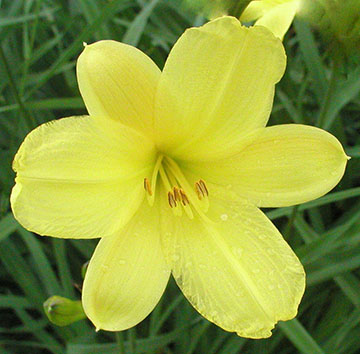 |
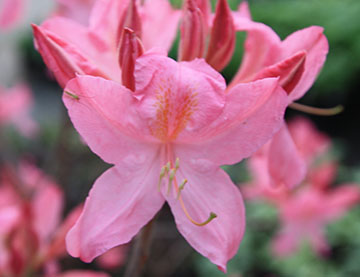 |
Hemerocallis 'Flavina', is one of the earliest daylilies to bloom for us, and very fragrant. |
Rhododendron 'Marie Hoffman' is an early blooming deciduous azalea, and extremely fragrant, with a clove-like scent. |
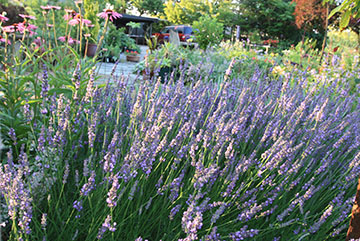 |
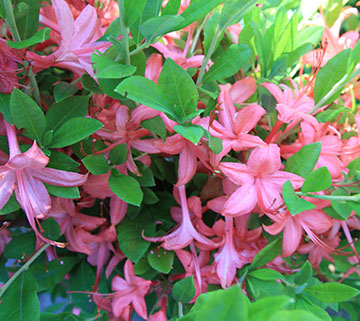 |
Lavandula 'Phenomenal' - A very fragrant lavender for summer bloom. |
Rhododendron 'Millenium' - This deciduous azalea blooms in July with spicy fragrant flowers |
 |
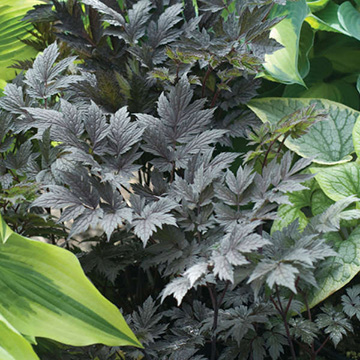 |
Peonies offer beauty and fragrance in June. |
Cimicifuga 'Chocoholic' - Bugbane is a shade loving perennial with tall wands of very fragrant flowers in late summer. The dark chocolate colored foliage adds interest. |
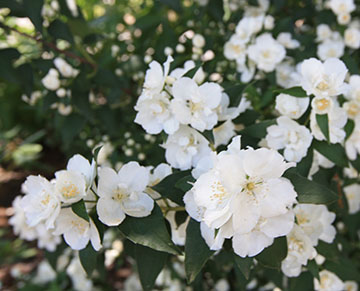 |
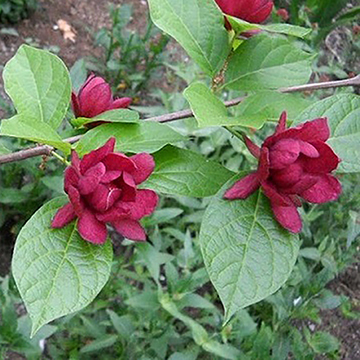 |
Philadelphus 'Janet Reidy' - a double flowering mock orange - smell like orange blossoms |
Calycanthus raulstonii 'Hartlage Wine' is a sweetshrub that blooms in late spring with stunning maroon flowers that fade to wine red. Fragrance is described as pineapple, strawberry banana. |
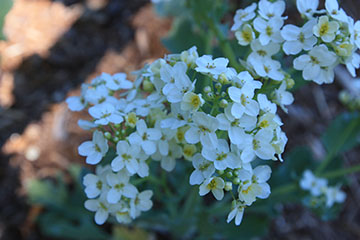 |
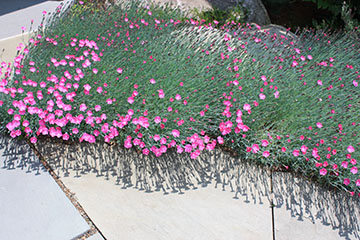 |
Crambe maritima - Sea Kale Flowers smell like honey. |
Dianthus 'Firewitch' - Cheddar Pinks Clove scented flowers. |
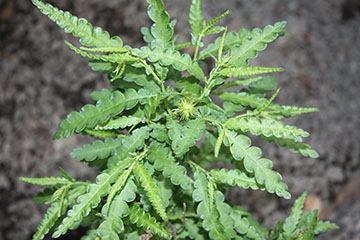 |
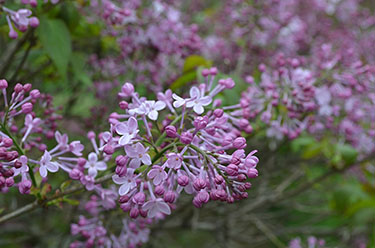 |
Comptonia peregrina - Sweetfern Fragrant foliage . |
Syringa meyerii 'Paliban', the Dwarf Korean Lilac is a very fragrant lilac.
|
Spring Pruning
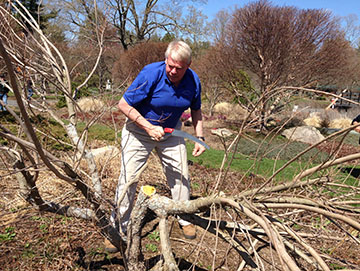 |
Breaking leaf buds and emerging flowers are signatures of Spring’s awakening in the garden. They also signal to gardeners that it is time for spring pruning. There are even a few shrubs and trees that require spring pruning to promote masses of blooms in June or late summer. However, if flowers are what you desire, never spring prune a plant that blooms on last year's woody growth. Here are some things to do now:
1. Branches broken or damaged by winter storms should be pruned and removed as a matter of course.
2. Some shrubs respond to severe pruning with vigorous growth and larger leaves. The purple smokebush (Cotinus coggygria 'Royal Purple'), or any smokebush cultivar, is a perfect plant to coppice, cut back to the ground. It will respond by producing exceptionally large leaves and robust and more colorful growth. You won’t get any smoke though, they bloom on old wood! Prune red twig dogwood in late winter or spring to produce shorter and more brightly colored foliage. Rejuvenate prune comptonia by cut them back to the ground.
3. Woody shrubs that have died back, can be cut back to the first viable bud. Clip back plants such as caryopteris, perovskia, Buddleia davidii and indigofera now to the first live bud.
4. The fall blooming bush clover, Lespedezia thunbergii, should also be cut back to the ground. It will grow to five to six feet and become a cascade of lavender flowers in September. Heptacodium miconioides (Seven Son Flower) is a small tree that blooms on new wood in September. Prune Heptacodium in April and May to reduce its size as well as promote new growth that will be covered with fragrant white flowers in the fall.
5. Prune shrubs that produce flower buds on new wood. Spring pruning promotes large displays of flowers in July and August. The smooth hydrangea, Hydrangea arborescens ‘Annabelle’ should be cut to the ground to promote new growth that will be topped with billowy clouds of white flowers mid summer. Hydrangea paniculata cultivars also bloom on new growth. They can be cut back by 2/3 to promote flowers. Calicarpa and Spiraea japonica also appreciate spring pruning. Blue hydrangeas, Hydrangea macrophylla, bloom on last years woody growth, which makes their flower buds prone to winter injury. If you spring prune a blue hydrangea, you will be removing this year's flower buds.
6. Remove the old and tired foliage from hellebores, epimedium and evergreen ferns now. New leaves will soon emerge, and the flowers on the hellebores and epimedium will show off better without the damaged foliage.
7. Cut back any grasses and perennials that you left in the garden for winter interest.
8. Lilacs should be pruned and dead headed immediately after they bloom. However, if you want to rejuvenate an overgrown lilac, forget the flowers and prune in early spring to promote new growth. Cut back 1/3 of the total plant. Lilacs will set flower buds in late summer to bloom the following May.
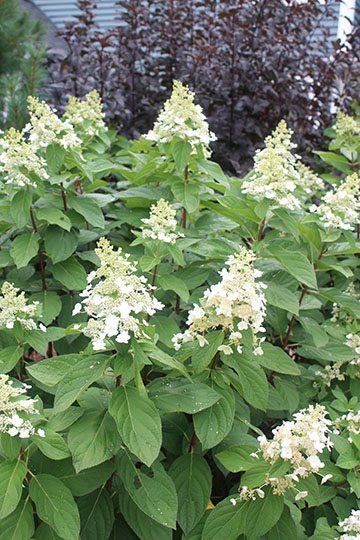 |
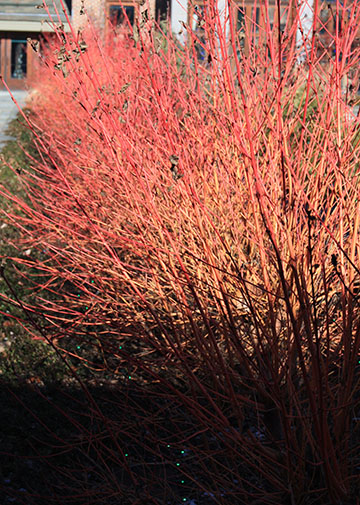 |
Hydrangea paniculata 'Tardiva' - cut back hard (1/2 to 2/3 the height) in spring. |
Cornus 'Midwinter Fire' - cut back 1/3 of plant to ground for colorful twigs the following winter. |
|
|
|
|
Caryopteris 'Longwood Blue' - cut back 1/3 in spring. |
Hydrangea arborescens 'Annabelle' - cut to the ground in spring. |
|
|
|
|
Prune seed heads off after flowering. To rejuvenate lilacs, forgo flowers and cut back 1/3 in early spring. |
Prune Indigofera ambylantha to six inches in early spring. |
|
|
|
|
Cotinus 'Grace' Coppice Smoke Bush to the ground in early spring for great foliage color, although no flowers. |
Cotinus 'Golden Spirit' can also be coppiced in spring. |
|
|
|
|
Heptacodium miconioides - prune in early spring to reduce size and promote September flowers. |
Lespedezia thunbergii - cut to the ground in spring for September bloom. |

